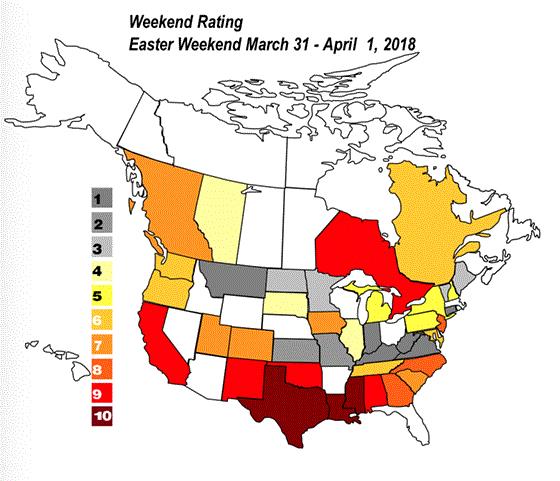The spring weekend ratings have begun!
Now, if only spring would begin, as well … at least in places (like my back yard) where it should be 55F and sunny during the day instead of 35F and snow flurries. Boy, what a slow start!
Despite many of you still having to shovel your way into the greenhouse, you still took the time to send in 68 scores from 37 states and four provinces. The results for the first weekend of April, which just so happened to be Easter weekend? A dismal 5.3 in the U.S. and a slightly better 6.4 in Canada.
That’s worse than last year’s first weekend of April, which scored 6.1 in the U.S. … but Canada did much worse last year, at 4.2 (Easter was the middle of April). The prior year, 2016, saw Easter falling one week earlier, in late March, yet Easter weekend scored 6.6 in the U.S. and 7.1 in Canada.
Going back in my eight years of weekend survey records, it looks like 2018 is the lowest score ever for the U.S. for this weekend—2014 was close, with 5.5; and 2015 was only slightly better, at 5.6.
Conversely, Canada’s 6.4 is the strongest early April score we’ve seen—records on both ends, in other words!
Here’s the map:

You can take heart that the South and West are doing well! That means that, once spring does finally arrive, it should be a good one. I got nine scores of 10 (including a “10++++” from Louisiana), which balance out the ten 1s I got from growers and retailers who are still snowed in. Here are a few comments from the happy folks:
“It has been a 10 since the week of January 29.”—William Massey, Hickory Hill Nursery, Louisiana (William is the chap who sent in the 10++++)
“Best March ever, up 13% from last year.”—JD Boone, Dothan Nurseries, Alabama (he gave the weekend an 8 and the month of March a 9)
“Texas and New Mexico [were] 9 for March. April for the same area was a 9.”—George Freas, Ball Seed sales rep
“We had a great weekend, despite cool weather. Saturday was chilly and breezy in the morning, which slowed down sales somewhat, but at least it wasn’t raining! Customers who bundled up to come in were ready to spend, so we had a good weekend.”—David Vos, Vander Giessen Nursery, Washington (He scored the weekend an 8.)
Some folks did well even in states like South Dakota, where you don’t expect good results this early:
“We had an exceptional day, all things considered! We have really been fighting the weather (today there is snow on the ground and single digits last night). On Saturday (we’re closed on Sunday), we sold a little bit of everything: seeds, containers, houseplants, home décor and even some bareroot trees! Lots of interest in nursery and greenhouse plants, but everyone is waiting for this weather to break … me, too!”—Laura Kalf, Landscape Garden Centers, South Dakota (score of 7.5)

Where it was bad
Much like the girl with the curl, where Easter was bad, it was very, very bad:
“Here in Kansas City, Missouri, our Easter was a minus 10 [note: I put her down for 1, because that’s as low as my scoring scale goes]. The high temperature was 27, with snow, freezing rain and sleet. To top it off, we have highway maintenance, and only one of our four ramps is open. I have been in this business 43 years, and this is absolutely the very worst spring in all those years!”—Sherry Mistretta, Heartland Nursery
“Cold, cloudy, WINDY, some snow … a few lookers warming up post-Easter egg hunt, but shoppers were few and far between.”—Jeri Zirbel, Caras Nursery & Landscape, Montana (score of 3)
“A Polar Vortex stuck over Hudson Bay is keeping the Canadian Prairies fairly irritable as we live through an extreme cold snap. No sales here for Manitoba.”—Duayne Friesen, Ball Seed
Meanwhile, up in Canada …
Why do I treat Canada like an afterthought, when they scored 1.1 points better than we did (other than Manitoba and its Polar Vortex, that is)? And they’re further north! Seems the country with the highest weekend score should be listed first, right? I guess I could argue that I do it alphabetically, so America comes first. Anyway, things were pretty good up there, with Ontario scoring 8.5 (including a 10) and BC scoring 7.3. Quebec was 6 and Alberta 4, for the average of 6.4.
Here are some comments:
“I rate Easter weekend an 8. Temperatures still 50-58F daytime and 32-36F at night, and I am being asked to bring in tomatoes, bedding plants and geraniums because all the box stores, grocery stores and so-called “good” garden centers have them in except for us. We had good frost last night and I heard reports of light snow in some areas. Hope I am able to keep my standards up and not let the almighty dollar rule my decisions. Until next week, having fun in B.C., Canada.”—John Derrick
‘Fantastic Easter weekend—all Easter plants sold well, as well as pansy planters and pansies and primula.”— Rosie Lombaert, Belgian Nursery, Ontario (She scored it a 10.)
In Calgary, Alberta, Kristen Busse is keeping her staff motivated with a fun contest: a “Snowbank Pool.” It’s $2 per guess of when their largest snow pile completely melts away. (May 10 is the latest guess so far, she says.) As for the weekend, she rated it a 4, saying, “Snow and a cold north wind kept the customers away. The customers that braved the weather were buying, though.”

How is Spring so far in Jolly Olde England?
I love getting reports from other countries, so we can see that we’re not the only ones doing well—or suffering. Here’s a report from long-time reader Colin Edwards of Woodlark Nurseries, a pot and bedding plant grower in North Surrey (he says they’re next to the famous Wisley Gardens):
March has been a disaster, weather-wise. We had two bouts of snow and the rest of the month has been wet and cold. Pansy, primulas, ranunculus, wallflower and pot tetes (tete-a-tete daffodil) are backing up, which is leading to space issues for potting summer bedding.
We have just had the Easter break, and, as it does at Mother’s Day, wet and cold led to disappointing sales. We put some early summer bedding in—geraniums and osteos, which sold okay—but we really want to clear the spring bedding first.
The season is three weeks behind last year; we just need the bloody weather to improve! For us in the South of England it has been a long winter!
What Millennials want … and when
Long-time reader and weekly survey respondent Dick Lahey of Merrihew’s Sunset Gardens in Santa Monica, California, wrote in with his weekend score and some comments:
“8 to 9—It's all about the weather [note: I averaged that to 8.5.]. If it rains, we close because no one comes in. We did have some low clouds and fog later in the month, but made up for it the minute the sun popped out.”
Dick also made an interesting comment I thought was worth sharing:
“People are finicky out here, coupled with a new dynamic going on with the Millennial trends. We have a steady supply of younger garden enthusiasts who want what they want when they want it (code for ASAP) and are willing to pay for it. As an ‘old-timer,’ my days are numbered and my perspective dated. We got where we are because we were willing to change, and sometimes that change might mean to get out of the way.”
Dick, I give you credit for being open-minded enough to admit that you may not have what it takes to meet the needs of today’s customers and are willing to let the next generation of retail staff make the decisions—and take on the responsibility. Because it’s never easy knowing how to meet the needs of customers!
But I will add this, Dick: Don’t put yourself out to pasture yet, because great customer service and in-depth product knowledge will never go out of style.
Got thoughts on this? Weigh in HERE.

Spring-season disease webinar Wednesday!
Want the latest information on controlling pythium, botrytis, leaf spots and anthracnose? Of course you do! Which is why you must tune in to my first webinar of the Spring 2018 season, titled “Don’t Balk at Plant Diseases—Strike Them Out!” featuring Purdue plant pathologist Janna Beckerman (a veteran of my webinars).

It’s slated for Wednesday, April 11, at 1 p.m. Eastern/Noon Central. Sign up at www.growertalks.com/webinars.
Janna is a big baseball fan, and seeing how that season has just started, too, she will be sprinkling her presentation with sports references. For instance, in baseball, three strikes means you’re out. With diseases, if you take care of three key areas—culture, identification and solutions—you’ll strike them out. “Coach” Janna will give you a refresher on those keys to best management practices as they relate to the four “big-league” diseases above.
If you’re a greenhouse or nursery grower and want to be at the top of your disease management game, be sure to step up to the plate and attend! (Sorry, now she’s got me doing it!).
Play ball! I mean, see you there!
Generously sponsored by BASF, who puts the “free” in free webinar.

Is your water good enough for greenhouse or nursery use?
Assuming you are watering plants at a greenhouse or nursery, I would hope that it is! But to be certain—or to test a new water source—there’s a new tool you can use that interprets water quality data and tells you if it’s suitable for irrigation.
Developed by Dr. Rosa Raudales of the University of Connecticut and Dr. Paul Fisher of the University of Florida (go Gators!) as part of the Clean WateR3 initiative, The “WaterQual” tool lets you simply plug any of the known numbers you get from your testing lab—pH, EC, alkalinity, total dissolved salts, suspended solids, and the like—and it will interpret your lab results and offer recommendations.
For instance, I typed in some fictitious sample numbers, including a pH of 7, and the tool recommended this:
pH levels this high means some pH adjustment (addition of acid) may be required in the spray tank with certain agrichemicals - check pesticide label. Also test alkalinity to evaluate effect on pH of the root substrate. If alkalinity and pH are both high it may be necessary to inject acid into the irrigation water or use an ammonium-based (acidic reaction) fertilizer.
I also said my EC was 33 (a typo; I meant to put in 3), and the tool said:
Dissolved ion concentration is very high, and not suitable for irrigation. Treatment is definitely needed, such as reverse osmosis or blending with a more pure water source.
Check it out at http://cleanwater3.org/wqi.asp.
Clean WateR3 is a federally funded specialty crops initiative focused on research and outreach that helps growers “reduce, remediate and recycle” their irrigation water. You can subscribe to their free newsletter HERE.

$1 million more for Floriculture and Nursery research
Speaking of funding, the Floriculture and Nursery Research Initiative (FNRI), a research program of the USDA Agricultural Research Service, has been funded to the tune of an additional $1 million, says the Society of American Florists, which has had the full court press on in Washington for at least two years. This is on top of the current funding of $4.6 million. The funding is part of the omnibus spending bill approved by Congress and signed into law in late March by President Trump.
The figure represents the largest single increase in almost 20 years for FNRI, which plays a critical role in generating scientific research on high-priority issues that affect all segments, including post-harvest technology, water quality, and pest and disease management. Half is for floral and half is for nursery. The research program started with $1 million in 1999.
“This is very big news,” said Shawn McBurney, SAF’s senior director of government relations, in a press release. “This is a huge accomplishment for the floral industry, and it would not have happened without the support and hard work of SAF members. This proves that conversations between SAF members and lawmakers and their staff during Congressional Action Days have made a real difference.”

How many tulips?
A few weeks ago, while studying the tulip industry in the Netherlands, I wanted to find out just how big the U.S. market is for tulip bulbs intended for cut flower production. My hosts have obliged with that number.
In their most recent data, about 50 tulip growers in the U.S. received 437 million tulip bulbs. That compares to 988 million bulbs going to the other countries outside of the EU (they don’t have export stats for EU countries). Canada received about 173 million of the 988 million.

I’m told that the total number of tulip bulbs produced in the Netherlands (and by contract growers in the southern hemisphere) is about 6 billion. The best guess is that 70% (4.2 billion) of those is for forcing (cuts and pots) and the remaining 30% (1.8 billion) are dried. I thought I’d try a bit of cut tulip math:
Total cut tulips 4.2 billion
U.S. 437 million
Rest of world 988 million
Total 1.425 billion
Wouldn’t it stand to reason that if there are about 4.2 billion tulip bulbs grown for cuts, and the U.S. and the rest of the world outside the EU grow 1.425 billion of those, then the remainder, 2.775 billion, would be credited to the EU?
Also, at 437 million, the U.S. is growing about 10% of the world’s cut tulips.
Put that in your Dutchman’s pipe and smoke it!

Finally …
It’s plant shipping season, and it’s still cold and snowy in many places, which is why Karen Brohl’s photo is so funny … except it’s not funny (I enlarged the signs on the door so you can read them):
Wrote Karen, “Ugh! Good thing I saw them to pull them in[doors].”
See you next time!

Chris Beytes
Editor
GrowerTalks and Green Profit
This e-mail received by 22,980 loyal readers!
Thanks to my loyal sponsors, who help me reach the 22,980 readers of Acres Online in 66 countries. Want to be one of them (a sponsor, that is)? Give Paul Black a shout and he'll hook you up.